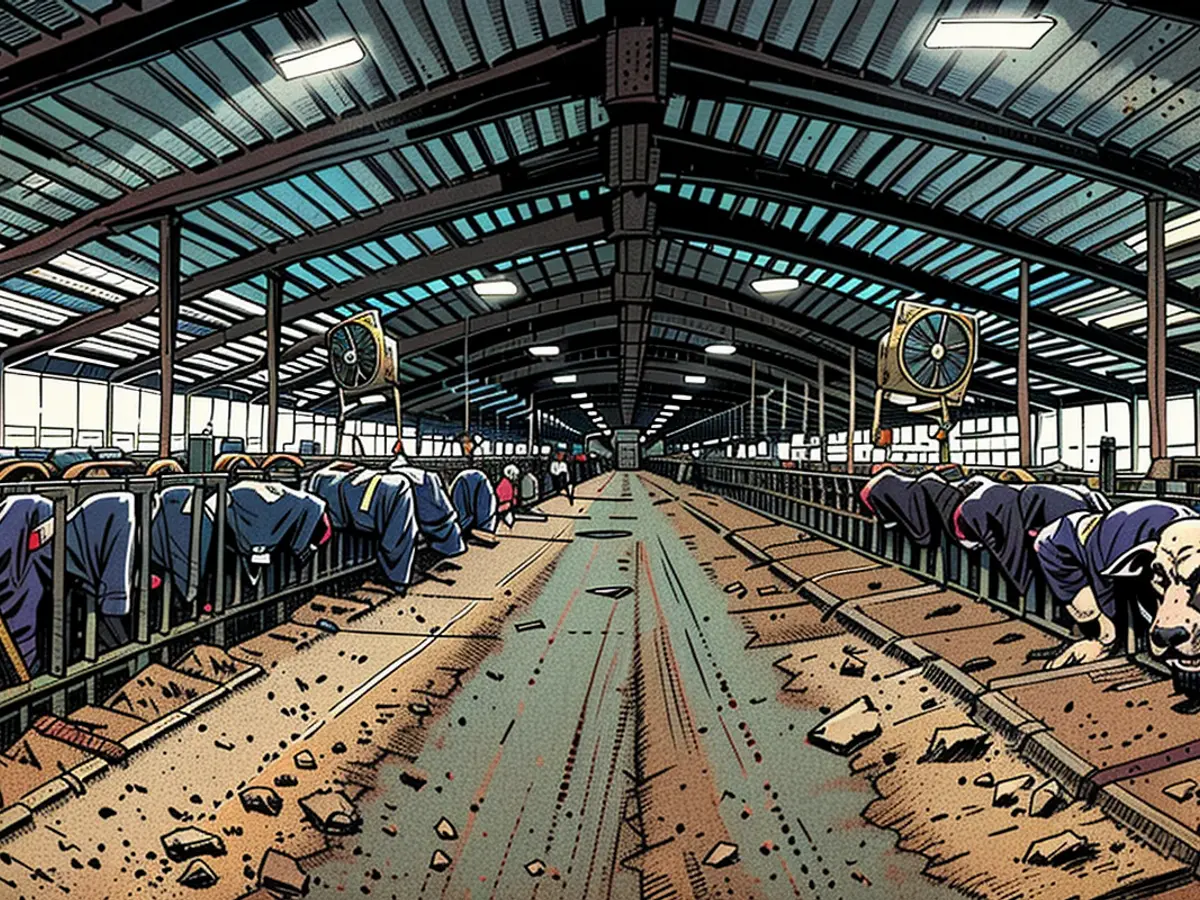"The cows have absurdly high virus loads in their milk"
The H5N1 Bird Flu Virus is spreading among dairy cows in the USA. "It's concerning what's brewing there," says Virologist Isabella Eckerle, an expert in new and pandemic viruses, in a conversation with ntv.de. She sees no immediate danger for Europe yet, but without countermeasures, new, dangerous virus variants could emerge between cows, humans, birds, and domestic animals - and the situation could quickly get out of control.
ntv.de: In the spring, the H5N1 Bird Flu virus first appeared in North America among cattle. By the end of June, US authorities discovered infected dairy cows in over 130 farms in twelve states from the Canadian border to Texas. At least three people have been infected. How do you assess this: Has the virus crossed a threshold with the outbreak among livestock?
Isabella Eckerle: H5N1 is not a new, unknown virus. We have known avian Influenza-A viruses, the causative agents of bird flu, for decades, primarily from Asia. In previous outbreaks, there have also been human infections, mainly with intensive contact with infected poultry or dead wild birds. Avian influenza is therefore a known zoonosis, which has not yet acquired the ability to effectively transmit from person to person. However, the virus has been on the list of potential pandemic viruses for some time.
Outbreaks of avian influenza among chickens, geese, or swans have also occurred in Germany. What's new?
Approximately four years ago, something very unusual began: The Influenza-A subtype H5N1 spread very strongly among wild birds, and in the previous summer, the virus suddenly experienced an enormous geographic expansion, even to North America and the Antarctic, where it caused catastrophic population losses of bird species. The virus was also found in marine mammals, it was discovered in foxes, and there were cases in domestic cats. This alone would not be unusual: Through local epidemics among wild birds, there are more sick or dead animals that are then consumed by meat-eating animals. However, it is not yet fully understood why this virus suddenly developed such dynamics. Additionally, there were early indications that the virus might not only transmit between birds, but also between mammals.
Reports from the USA came about H5N1 outbreaks among seals and infected polar bears. When did you and your colleagues become really alarmed?
The alarm went off for us when there were increasing reports of transmissions between mammals. But with the detection of the H5N1 Bird Flu virus in dairy cows in the spring of 2024 in US farms, the situation suddenly took on a completely different character. This was a big surprise for us because cattle were not among the animal species we had on our radar for this virus. Since then, development has progressed rapidly. The virus seems to reproduce mainly in the uterus of cows.
How did the bird-specializing virus manage to spread among dairy cows in the USA? How did H5N1 make the leap from bird to cow?
It appears that an entry was made into the uterus of a dairy cow through an unknown mechanism in the USA. The exact details of how this occurred are still unknown. A virus cluster was registered, which was also found in birds in the USA. Since then, this virus has been spreading among cattle herds, either at a rapid pace or it had already spread and went unnoticed for a longer period of time. It is difficult to evaluate this, as more and more affected farms have been reported in recent weeks. The large spatial extent over several states suggests that we are now dealing with cow-to-cow transmission.
How do cows get infected with H5N1? Are there any theories about this?
We know from earlier experimental studies that cows do not actually get infected with bird flu. In the laboratory at the Friedrich-Loeffler-Institute, they attempted to bring cows into contact with the pathogen via their respiratory tract and observed that it did not work easily. The most likely hypothesis is that the infections in the USA occur via milking equipment. It is striking that in the USA, farmers measure absurdly high virus concentrations in milk from infected cows. These are really high values: The virus load in the milk is sometimes higher than what we can cultivate in the lab on cell cultures. Infected cows produce highly infectious milk. It seems that the virus has found a perfect environment in the uterus to reproduce.
Do cows get infected in the USA while being milked?

There are several indications: In US farms, there are often hundreds of cows under one roof. Milking is a process during which milk naturally flows out. For example, cows are milked to stimulate the release of oxytocin and initiate milk flow. Milk sprayers or droplets fall on the floor during milking. It is cleaned extensively, including with high-pressure cleaners. However, one can easily imagine: There is a very humid, warm environment with a lot of environmental contamination. With the highly infectious milk, it is easily explained that almost all cows that come into contact with an infected cow in the milking stand can get infected relatively easily. However, it is still unclear how the transmission between farms takes place. It is possible that infected cows simply transported from one farm to the next via animal transport. There seems to be a lot of exchange between dairy cattle herds.
How dangerous is infected cow's milk for humans?
A person working in a barn with infected dairy cows without a mask and safety goggles is evidently exposed to large virus quantities. When we think of milk sprayers during milking, perhaps fine mist aerosols and smear infections that milk droplets get into the eyes, it seems plausible that the virus gains access to humans there. So far, only three human infections have been confirmed in the USA, but testing is done very rarely there. Although thousands of people are under observation, only approximately 350 of them have been tested according to the US Disease Control and Prevention Center (CDC). Considering that thousands of cows are kept on a single farm, the number of endangered farm workers should be much higher. The good news is that the three infected individuals did not get seriously ill. Two had conjunctivitis, and one had a respiratory infection. This also seems plausible, as we know that the eyes are an excellent entry point for Influenza viruses like H5N1.
What measures have the US health authorities taken so far?
In my opinion, the situation in the USA is not under control because very little testing is done. For affected cattle farmers, there are few restrictions, and it is unclear what happens to the infected animals. They remain in the herd? A culling like in poultry is not an option because cows are too expensive. Moreover, infected cows, as far as we know, do not get seriously ill.
How does bird flu express itself in dairy cows?
Infected dairy cows show disease symptoms, but they do not necessarily die from it. The cows develop a fever, they suffer from a typical mastitis, that is, an udder inflammation, and their milk production decreases. However, the animals seem to recover quite quickly. The usual measures for animal diseases like isolation, culling, and controls are therefore unlikely to be implemented consistently.
With this approach, the virus can continue to spread in cattle herds. Why don't the US authorities intervene more strongly?
The approach of allowing the virus to run its course freely is criticized internationally. The idea that such an outbreak could burn itself out does not convince me - especially since new infected farms are constantly being discovered, and there are many contacts with other animal species. The H5N1 variant in cows has already been found in birds, and we still do not know how birds come into contact with contaminated milk. Another surprise were the H5N1 infected mice found near the affected dairy farms. This is indeed surprising because rodents have not been particularly susceptible to this virus before.
You mean the bird flu outbreak in cows could spread to other animal species that live closer to humans?
It is certainly worrying what is brewing there. In principle, it's about simple statistics: The more opportunities the virus gets to reproduce and spread to new hosts, the more likely it is that a combination of mutations will occur that functions effectively in mammals. I am particularly concerned about what will happen if the H5N1 outbreak in the USA continues unchecked and perhaps leads to Ping-pong infections between chickens, birds, mice or other wild animals. Then the likelihood is very high that a specifically adapted virus variant will emerge that spreads in mammals. Then the virus could quickly reach Europe through infected animals or people.

Bird flu outbreaks have occurred more frequently, even in Europe. Why have very few people been infected with H5N1 so far?
This virus is actually very well adapted to birds. As a disease agent in humans, it has no particularly high zoonotic potential. Viruses do not develop from one moment to the next into a new pandemic risk, but rather go through several stages that an agent must take to adapt to a new host before it can spread in a new population. For H5N1, there are still quite a few hurdles in terms of humans.
What protects us from bird flu so far?
The virus would first have to adapt better to mammalian cells, adapt to human receptors, and then also overcome human immune defenses. These are still many steps, and one could say that H5N1 is not yet at the top of the ladder. But we also know that the more infection chains there are and the longer the virus circulates in mammals, the more likely it is that it takes step by step and eventually reaches the top. In addition, there is another problem: The virus has established itself in cattle. This means that veterinarians have to keep an eye on another animal disease, and economically it also plays a role. Above all, however, the virus has now reached a species that is in close contact with humans. Spillover infections are programmed in.
Are there any findings about the risk that the virus from US cattle will be transferred to European dairy herds?
There seems to be no exchange in the trade of live cattle between the USA and Europe. Even with the import of meat or dairy products, the transfer would be rather unlikely, especially since the cows would apparently have to come into contact with raw milk. At the beginning of the US outbreak, there were reports that in affected farms, chicken manure had been fed to cattle. The milk cows could have come into contact with contaminated chicken manure in this way. In Germany and the EU, fortunately, the feeding of chicken manure is prohibited.
How high is the infection risk for consumers, for example when handling cow's milk?
Raw milk and raw milk products pose a risk simply because the virus load in the milk from infected cows is extremely high. With pasteurized milk, it looks different, especially when it comes to bulk milk, which is mixed milk from a large number of cows. There might be a certain dilution effect. And in general, only pasteurized milk is sold in the market. Through the short heating, which is proven experimentally, the virus load is significantly reduced. In milk in supermarkets, H5N1 in the USA can still be detected in samples via PCR test. However, it is no longer infectious. The virus load in pasteurized milk products is likely negligible. However, milk from infected cows should not appear in the supply chain, as it seems to be the case in the USA.
How big is the risk that the avian flu outbreak in the USA will spread into a pandemic?
We have a real black-and-white situation here: The risk still appears manageable, as there is no human-to-human transmission. However, if such infections were to occur - that is, continuous transmission of H5N1 in the population - we would be in a critical situation. And that gives me stomach aches: If we observe a transmission of the avian flu virus between humans, it would be too late for containment measures. The window for containment is still open: Ideally, we should recognize zoonotic viruses and take action while they are still circulating in the animal reservoir.
How well is Germany prepared for possible H5N1 cases? Is there more testing done here than in the USA?

The Friedrich-Löffler Institute has recently published an updated risk assessment for avian influenza. According to this, there have been no H5N1 cases in Germany or the EU in cattle or humans. Therefore, there is currently no reason to test employees in European dairy farms. And even if an outbreak were to occur among dairy cows, it would run differently here than in the USA. The legal framework is fundamentally different: European authorities have much more leeway and can make decisions for disease control in doubt.
Would a mutated avian flu virus be noticeable in routine diagnostics?
In principle, yes, but there are certainly differences between laboratories, so I can only make a general statement with difficulty. Influenza diagnostics work in our center so that we can also detect new pathogens, and in addition, we also have the Swiss reference laboratory for human influenza viruses here. Most PCR tests for the detection of influenza A viruses should also respond to Influenza A/H5N1, and many tests show the subtyping directly. We find out quickly whether it is H1N1 or H3N2. If a PCR result is positive for influenza A but does not return to one of these two seasonal subtypes, that would be a warning signal for us, and we would look for unusual influenza types and zoonotic viruses. The monitoring at the human-animal interface is still not optimal with us.
What would you suggest doing now?
In the USA, urgent measures must be taken immediately to stop the spread of this Virus and eliminate the pathogen from the cattle population once again. In addition, other animal species on these farms, including wild animals, as well as all people in contact with infected cattle, should be closely monitored - not only through virus tests, but also through antibody studies. At the same time, diagnostic capacity should be built up, especially in the USA. Every lab should be able to quickly confirm or exclude such cases. Even though I don't currently expect that we will see increased cases in humans in the near future: One should consider how our vaccine supply looks, as well as the availability of medications for influenza treatment, and the availability of antibiotics for treating secondary bacterial diseases that often occur after influenza infections - should the virus ever make the leap to humans.
We must urgently understand how the transition from bird to cattle in the USA actually occurred - so that it doesn't happen again. Unfortunately, it is still very unclear in the US. This is the crucial point. We still don't know how the avian influenza virus got into the cattle. It's strange: Of course, environmental contamination could have been a factor, such as a dead bird on a pasture. However, this virus has been present in birds for a long time. And in Europe, we have had H5N1 in wild birds for a long time, and it has never made it to the cattle herds here. We must find this previously unknown transmission mechanism.
Are we at the beginning of a new pandemic?
H5N1 is currently not a virus with high pandemic potential. We are still far from that. We can see from the virus lineage that the transition from bird to cattle has not occurred frequently, it was a single occurrence. And in the virus sequences, we can see that fortunately, there is still not much adaptation to livestock. The question is: What happens in half a year, in a year, or in five years, if we allow the virus to circulate unchecked in livestock populations?
Overall, we could also more strongly pursue the so-called One Health approach in Germany, and not only in dairy farming, but also in poultry farms or in pig farming. There are also influenza strains there. For example, if an infection is detected in a livestock farm, then immediate regulations should apply in that farm for all workers, including medical care. These are still separate areas: Veterinary medicine on one side and human medicine on the other. However, animal health, food safety, and public health always belong together.
With Isabella Eckerle spoke Martin Morcinek.
- The concern over the H5N1 Bird Flu virus spreading among dairy cows in the USA could lead to the emergence of new, dangerous virus variants that can infect a variety of animal species, including humans.
- Isabella Eckerle, the virologist, emphasizes the importance of taking immediate countermeasures to prevent the situation with the H5N1 Bird Flu virus from getting out of control, as it has the potential to mutate and become a pandemic virus.
- The current outbreak of H5N1 in dairy cows in the USA is a cause for concern because it marks a leap for the virus from its usual avian hosts to a new species, with the potential to spread to other animal and human populations, much like how the Avian flu led to the 2009 swine flu pandemic.








